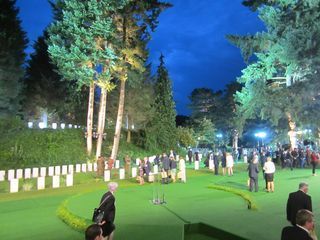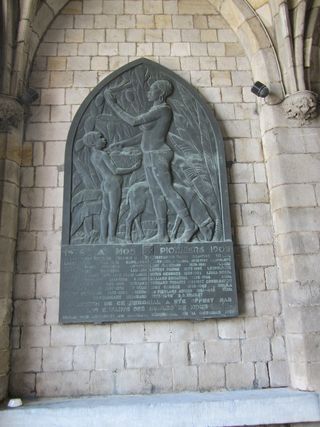St Symphorien: making up not breaking up
I was dead lucky last night, as I got to go to the WW1 commemorative event at the cemetery at St Symphorien, just outside Mons in Belgium. The reason is that I have been, for a few months now, on the Government Advisory Committee for the Commemoration of WW1, and the members could more or less choose which of the big three August 4 events to go to. I felt that -- despite the time and considerable expense -- I was only going to feel really comfortable and at home in a commemoration that involved men and women from the different "sides" in the War: where we could celebrate reconciliation and be thankful that we were, for the most part, no longer killing each other in Western Europe (I'm choosing my words carefully).
Besides, I had been to St Symphorien on a reccy a few months ago and found it extremely moving. It is, I think, the only WW1 cemetery which has both Commonwealth and German graves, in roughly equal numbers.
Anyway on this occasion there were about 500 people in the audience, some the relatives of those buried (both German and Commonwealth), lots of soldiers from all over the place, local people and some royals and senior politicians. There was Kate, Wills and Harry, plus Cameron and the Archbishop of Canterbury -- not to mention the King and Queen of the Belgians, the Presidents of Ireland, Germany, the European Commission, and so on .... Or so the programme said. To be honest, though I know their names, I dont have much facial recognition on European royalty and top brass politicians (I can't honestly, at sight, tell my King Philippe from my Manuel Barroso).
The whole commemoration lasted about an hour; it was excellently choreographed by Nicholas Kenyon (presented by Dan Snow) and featured recollections, music and performances, British, Commonwealth and German. Everything was sub-titled in German or English on the big screens. Even in the tea tent, there were two military bands: one British, one German.
It was extremely moving -- and, as I hope you see from my pictures, beautiful. It all happened over a glorious sunset, and the performances used the extraordinary space of the cemetery, which is full of glades, hillocks (it is on the site of an old phosphate mine) and little "clusters" of tombs from different regiments and nationalities. The aesthetic is very different from the more ordered feel of the usual Commonwealth War Graves cemeteries.
The emotional highlights of the commemoration for me were the German cellist. Jan Vogler, playing Bach in one of the glades (that's him with the Kenyons on the right, with his cello on his back), the great-niece of John Parr (the first British casuality) reading the letter that Parr's mother wrote to the War Office trying to find out what had happened to him after she hadn't heard of him for 10 weeks, and the band playing wartime soldiers' songs, German and English ("It's a long way to Tipperary". "Muss ich denn"). But it's hard to pick favourites.
It was also rather touching to see great fraternisination going on afterward between the serviceman of the different nations, with some splendid kilts brushing against the rather less flamboyant German blue (I just hope they werent swapping notes on the latest hardware).
To be honest there was hardly a jarring note. Though I rather wish that David Cameron had resisted the understandable temptation to say that we were resisting "the domination of a continent"; if that was for anyone to say, it was for the President of Germany and he had already said as much at Liège that morning. And, frankly, I think I shall go to my own grave finding some aspects of military goings-on a bit "not my cup of tea" (why soldiers can't hand over flowers or lamps between each other without clicking their heels and saluting, beats me -- but there you go).
But the reconciliation theme really did come over loud and clear, as well the evenhandedness across te nations. And with any luck that will go on as the four years of commemoration continue (maybe it should be a rule that we dont remember the British dead, without remembering the dead of some other country -- after all we didnt sustain the worst losses).
And maybe it will be the start of our thinking a bit harder about the continuing impact of World War 1 -- and in a more complicated way. There were two significant vignettes of this at St Symphorien and in Mons.
In the goody bag we got there was a wonderful book celebrating the work of the Commonwealth War Graves Commission. I flipped through it while we were waiting for the royals and co to do all their hand shaking. It explained how many graves the commission looks after and where they are. Amongst hundreds of thousands, there are over 3000 graves in Gaza from WW1. Heaven knows what state they are in at this very minute, but their presence there (after the British took Gaza city in 1917) is a hint of a complicated story of conflict in that region which reaches down a century.
And in Mons town centre there is an extraordinary bronze relief at the entrance to the Town Hall.
It commemorates what was then, just a few years before the start of the war, taken by the citizens of Mons to be Belgium's fine record of generosity to the people of the Congo. It's odd how when we recall how we went to the rescue of plucky little Belgium, invaded by Germany, we dont tend to mention what atrocities had been going on, in Belgium's name, in the Congo.
That's not to say that we should not therefore have gone to Belgium's defence. It is to say that the rights and wrongs of the world in 1914 were a lot more complicated than we tend to allow.
After all a lot of Indians believe that India was fighting against Britain in WW1. I wonder why.
Mary Beard's Blog
- Mary Beard's profile
- 4112 followers






